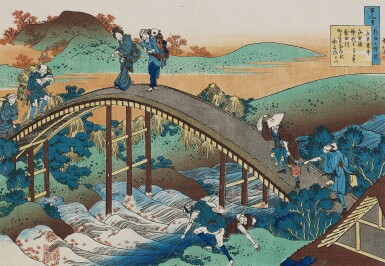Private Collection of Fine Japanese Prints
Private Collection of Fine Japanese Prints

KATSUSHIKA HOKUSAI (1760-1849) POEM BY ARIWARA NO NARIHIRA ASON | EDO PERIOD, 19TH CENTURY
Lot Closed
October 8, 01:34 PM GMT
Estimate
10,000 - 15,000 GBP
Lot Details
Description
KATSUSHIKA HOKUSAI (1760-1849)
EDO PERIOD, 19TH CENTURY
POEM BY ARIWARA NO NARIHIRA ASON
Woodblock print, from the series The Hundred Poems [By the Hundred Poets] as Told by the Nurse (Hyakunin isshu uba ga etoki), signed saki no Hokusai manji, published by Iseya Sanjiro (Eijudo), censor's seal kiwame, circa 1835-36
Horizontal oban:
25.2 x 36.4 cm, 10 x 14⅜ in.
To view Shipping Calculator, please click here
S. Nagata, Hokusai Museum (Hokusai Bijutsukan): Tales (Monogatari-e), vol. 5, 2nd ed. (Tokyo, 1990), plate 139
The Japan Ukiyo-e Academy, Hokusai serial catalogue, Daimaru Museum, Tokyo, 29 December-11 January, exhib. cat. (Matsumoto, 1992), plate 84
W. Crothers, T. Kobayashi and J. Berndt, Hokusai, NGV International, Melbourne, 21 July- 15 October 2017, exhib. cat. (Melbourne, 2017)
For his last single sheet series of woodblock prints, One Hundred Poems Explained by the Nurse (Hyakunin isshu uba ga etoki), Katshushika Hokusai looked to an anthology of well-known poems, entitled Hyakunin Isshu (A Hundred Poems by a Hundred Poets), as his source. These poems, based on love and melancholy, were assembled by the thirteenth-century poet Fujiawara no Teika. Hokusai chose to visually recount the poems from the perspective of a fictional elderly nurse. Together with sixty-four preparatory drawings, twenty-seven published prints are known, each exhibiting bold colour and including a cartouche enclosing the relevant verse. The series was commissioned by the publisher Nishimura Yohachi and his firm Eijudo successfully issued five prints before closing down; the additional twenty-two prints were then published by Iseya Sanjiro’s firm Iseri, with the original Eijudo seal continuing to be employed.
The poem in this print is by Ariwara no Narihira (825-880), one of the Six Immortal Poets (Rokkasen) (translation by Joshua Mostow):
Chihayaburu
kami yo mo kikazu
Tatsutagawa kara kurenai ni
Mizu kukuru to waters
Unheard of
even in the legendary age
of the awesome gods:
Tatsuta River in scarlet
and the water flowing under it.
A lady, standing in the middle of a bridge, looks towards her male companions and points towards the flowing Tatsuta River below, as it meanders along the rocky waterbed. The surface of the water is covered in maple leaves. The print, with its colour palette of brown and red hues, is an ode to the autumn season and to the beauty of the maple tree, a symbol of peace and serenity.
For a similar impression in The Museum of Fine Arts, Boston, see accession no. 21.6728
